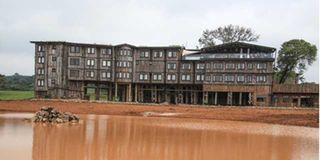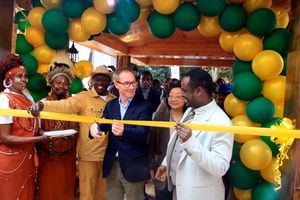
A view of Treetops Hotel inside Aberdare National Park on August 3, 2024, when the hotel was reopened after being closed since January 2021 due to the COVID-19 pandemic.
The reopening of the colonial-era Treetops Hotel in Nyeri prompts a recurring question: How can we effectively commercialise former colonial sites of privilege?
During a recent Town Hall meeting in Mombasa, President Ruto was asked about the commercialisation of the Old Town. It became clear that previous governments hadn’t given it much thought. The Ministry of Heritage appears to be in deep slumber, with no significant efforts made to preserve and promote these sites as historical landmarks.
In Wanjohi Valley, at the foot of the Nyandarua Ridges, we seem to have missed the opportunity to transform the former “Happy Valley” bungalows – infamous colonial spaces of debauchery – into tourism destinations.
The Happy Valley, known worldwide, attracted aristocrats, playboys, and merchants seeking pleasure in the remote interior. Numerous movies, documentaries, and coffee table books have chronicled the escapades of the colonial elite in this valley, yet we have failed to capitalize on this history to build a thriving tourism industry. These sites were also targets for Mau Mau freedom fighters, who sought to disrupt the colonial establishment.
Before celebrating the opening of Treetops Hotel, let me clear a common misconception. Many articles claim that the late Queen Elizabeth slept at this hotel before becoming queen on that fateful February night in 1952.

However, the original hotel, a modest two-bedroom structure atop a Mugumo tree, was burned down by Mau Mau fighters, leaving nothing behind. The current structure, built later opposite the waterhole, was not the same structure that Queen Elizabeth slept. But still, the modern Treetops is significant because of its ties to Kenya’s struggle for independence.
After the original Treetops was burned in 1954, the hotel’s proprietor, Sherbrooke Walker, who also owned the Outspan Hotel in Nyeri, planned to rebuild it at the same site. However, due to the ongoing Mau Mau uprising, the Mt Kenya Forest remained a no-go zone, forcing him to wait until 1957 when the State of Emergency was lifted. By then, an elephant had knocked down the fig tree stump.
Before its destruction, the owner had been informed that food destined for Treetops often ended up in the hands of Mau Mau fighters, thanks to collusion between freedom fighters and Outspan Hotel workers. Walker was, perhaps, horrified that he was the one feeding some anti- settler fighters.
He quickly alerted the army, and an ambush was planned at the site where food vehicles entered the forest. A writer later recounted the event: “The vehicle stopped, two Mau Mau stepped out of the trees, and the food was handed over. At the moment the Army went into action the Mau Mau were somehow warned, and though there was plenty of firing from both sides nobody was hit. Sherbrooke Walker blamed the failure of the ambush on the use of inexperienced soldiers just out from England. Whatever the cause, he did have the satisfaction of learning that his driver was involved…”
This incident, and the disruption of the food supply, led Walker to realise that his hotel would be targeted. That night he tried to evacuate what he could carry to Outspan. A few days later, the Mau Mau attacked and burned it down, leaving behind only an empty petrol tin as evidence. An era had ended.
One of Walker’s friends recalled, “All that was left for Walker to do was to carry back to the Outspan the brass plaque which had so proudly proclaimed to the world that in the tree a princess had become a queen... He knew that plaque would go back, and go back it did, though in a different tree.”
This plaque now resides in the modern Treetops, adding to its historical significance. That is why I am arguing that the story of Treetops and Outspan, if marketed correctly, could attract both domestic and international tourists to the Mount Kenya region. It could also offer backdrop to documentaries and films.
Outspan, which has also suffered neglect, is globally recognised as the place where Scout Movement founder Lord Baden-Powell spent his final years. During his three-year stay in “Paxtu”, Baden-Powell authored several books, including Birds and Beasts of Africa, Paddle Your Own Canoe, and More Sketches of Kenya. Though he passed away in 1941, his legacy endures through the Scout Movement, which we are all familiar with.
Each year on February 22, thousands of Boy Scouts and Girl Guides of various races march to Nyeri in his honour. It is disheartening that Kenya has not fully appreciated this legacy as a tourist attraction. The juxtaposition of Baden-Powell’s grave with those of soldiers and settlers who died during the Mau Mau period or were killed by wild animals highlights the harsh realities of colonial Kenya.
This contrast serves as a reminder of the dangers and conflicts that shaped the region’s history, set against the idealistic and peaceful vision of Baden-Powell’s scouting movement.
The County Government of Nyeri must think beyond politics and recognise the tourist potential of this circuit, a sentiment that should extend to neighboring Nyandarua County. Nyandarua’s sites of global significance have also been left to the vagaries of nature. The county wouldn’t be struggling to collect revenue if we had preserved the Happy Valley structures and developed the entire Wanjohi Valley as a hub for hospitality and entertainment. Why have we allowed those beautiful bungalows, rich in heritage, to fall into disrepair?
In Kiambu, the grounds where Chief Waiyaki wa Hinga was abducted after attacking Captain Purkis at Fort Smith remain intact, with some graves of Imperial British East Africa pioneers still in situ. If we’re seeking sites that can illuminate the history of our struggle, Fort Smith is a glaring omission. If we take pride in sites like Fort Jesus, a symbol of Portuguese conquest in Mombasa, and the Gedi Ruins as tourist attractions, then we should add more sites and rescue those that are falling apart.
However, our tourism industry is so fixated on the Big Five that we’ve forgotten how other nations capitalise on historical sites of foreign intrusion to market themselves. The British still sell tickets to sites of Roman Empire.
This is why I was saddened to see Treetops Hotel nearly join the ranks of the neglected Wanjohi Valley bungalows before it was rescued by the sons of Deputy President Rigathi Gachagua. Their rescue effort wasn’t just about reviving a hotel but about preserving a historical site.
They risked their money to breathe life into history – a sentiment sorely lacking within the Wanjohi Valley and elsewhere. Years ago, when Northrup Macmillan’s house overlooking Kilimambogo was deteriorating, I visited to document its heritage and connection to former US President Theodore Roosevelt.
This house also served as the prison for Italian Duke of Aosta, Prince Amedeo Savoia, after his surrender in Ethiopia during World War II. Notably, he was buried in Nyeri within a magnificent church built solely to house graves – unique in Kenya.
We, thus, need to rethink how we view and commercialise our heritage. These colonial sites hold immense potential as tourist attractions, and we cannot continue relying solely on the shrinking appeal of the Big Five. The restoration of Treetops proves that we can do it, but time is running out.







